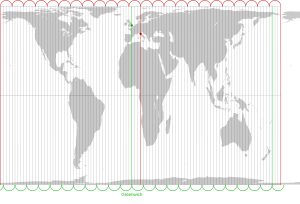Arno Peters facts for kids
Arno Peters (born May 22, 1916 – died December 2, 2002) was a German historian. He is best known for creating the Peters world map. This map is based on a special way of drawing the world called the Gall–Peters projection.
Contents
About Arno Peters
Arno Peters grew up in Berlin, Germany, with his brother Werner and his parents, Lucy and Bruno. His family often welcomed guests from other countries. His parents were involved in groups that worked for better conditions for workers. This showed Arno the importance of helping others. During World War II, his father faced difficulties from the Nazi government.
In high school, Arno was a talented athlete. He won titles in both cycling and swimming.
Early Career and Film
In the late 1930s, Peters went to Hollywood to study how American movies were made. When he returned to Germany, he used what he learned to improve German film production. In 1940, he released his own movie, Immer Nur Du, which was a modern musical. At just 25 years old, he was the youngest German filmmaker at that time.
Studies and Research
In 1945, Peters earned his doctorate degree. He studied art history and journalism at the Friedrich-Wilhelm University. His studies included a topic called "synchronoptic world history." This idea was a big part of his final paper, which was about "Film as a Means of Public Leadership."
Peters started talking about his world map as early as 1967. However, he officially introduced it to the public in May 1973 at a press conference in Bonn.
Later Life and Legacy
In 1974, Peters started the Institute for Universal History in Bremen, Germany. He was the director there. The University of Bremen gave him an honorary professorship. He continued his work in Bremen until he passed away on December 2, 2002.
Arno Peters' Work
Arno Peters was very interested in how information is presented to people. This led him to study "synchronoptic world history." This way of looking at history treats all parts of the world equally.
Synchronoptic World History
From his studies, Peters created a "synchronoptic world history" timeline. This timeline gave the same amount of space to all areas and times in the world. It covered history from 1000 BC to 1952 AD. His idea was that seeing all civilizations and countries at the same time helps us understand how they are connected. This timeline was published in 1952, before his famous map.
The Peters World Map
Through his work, Peters believed that most maps showed a Eurocentric bias. This means they made Europe seem more important or larger than it really was. Since he couldn't find a map that he felt was fair, Peters decided to create his own.
In 1974, he introduced the Peters World Map. He claimed it was the most accurate way to show the world. However, this map caused some debate. The way Peters drew his map had actually been used more than a century earlier by a man named Reverend James Gall. Also, Peters claimed his map was the first and only "equal-area" map. But there were many other equal-area maps already. An equal-area map shows the correct sizes of landmasses, even if their shapes are stretched.
Despite these criticisms, over 80 million of Peters's maps have been shared around the world. In 1989, Peters published The Peters Atlas of the World. At that time, it was the only atlas that showed all areas of the world at about the same scale.
See also
 In Spanish: Arno Peters para niños
In Spanish: Arno Peters para niños


